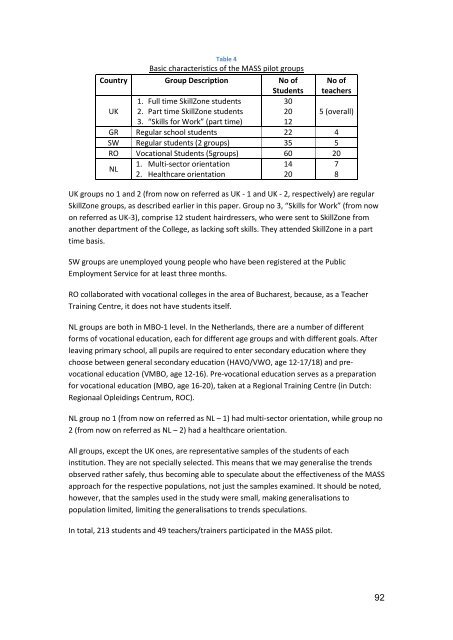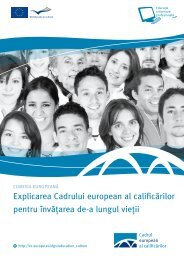Teaching and Assessing Soft Skills - MASS - Measuring and ...
Teaching and Assessing Soft Skills - MASS - Measuring and ...
Teaching and Assessing Soft Skills - MASS - Measuring and ...
Create successful ePaper yourself
Turn your PDF publications into a flip-book with our unique Google optimized e-Paper software.
Table 4<br />
Basic characteristics of the <strong>MASS</strong> pilot groups<br />
Country Group Description No of<br />
UK<br />
1. Full time SkillZone students<br />
2. Part time SkillZone students<br />
3. “<strong>Skills</strong> for Work” (part time)<br />
Students<br />
30<br />
20<br />
12<br />
No of<br />
teachers<br />
5 (overall)<br />
GR Regular school students 22 4<br />
SW Regular students (2 groups) 35 5<br />
RO Vocational Students (5groups) 60 20<br />
NL<br />
1. Multi-sector orientation<br />
2. Healthcare orientation<br />
UK groups no 1 <strong>and</strong> 2 (from now on referred as UK - 1 <strong>and</strong> UK - 2, respectively) are regular<br />
SkillZone groups, as described earlier in this paper. Group no 3, “<strong>Skills</strong> for Work” (from now<br />
on referred as UK-3), comprise 12 student hairdressers, who were sent to SkillZone from<br />
another department of the College, as lacking soft skills. They attended SkillZone in a part<br />
time basis.<br />
SW groups are unemployed young people who have been registered at the Public<br />
Employment Service for at least three months.<br />
RO collaborated with vocational colleges in the area of Bucharest, because, as a Teacher<br />
Training Centre, it does not have students itself.<br />
NL groups are both in MBO-1 level. In the Netherl<strong>and</strong>s, there are a number of different<br />
forms of vocational education, each for different age groups <strong>and</strong> with different goals. After<br />
leaving primary school, all pupils are required to enter secondary education where they<br />
choose between general secondary education (HAVO/VWO, age 12‐17/18) <strong>and</strong> pre‐<br />
vocational education (VMBO, age 12‐16). Pre‐vocational education serves as a preparation<br />
for vocational education (MBO, age 16‐20), taken at a Regional Training Centre (in Dutch:<br />
Regionaal Opleidings Centrum, ROC).<br />
NL group no 1 (from now on referred as NL – 1) had multi-sector orientation, while group no<br />
2 (from now on referred as NL – 2) had a healthcare orientation.<br />
All groups, except the UK ones, are representative samples of the students of each<br />
institution. They are not specially selected. This means that we may generalise the trends<br />
observed rather safely, thus becoming able to speculate about the effectiveness of the <strong>MASS</strong><br />
approach for the respective populations, not just the samples examined. It should be noted,<br />
however, that the samples used in the study were small, making generalisations to<br />
population limited, limiting the generalisations to trends speculations.<br />
In total, 213 students <strong>and</strong> 49 teachers/trainers participated in the <strong>MASS</strong> pilot.<br />
14<br />
20<br />
7<br />
8<br />
92





